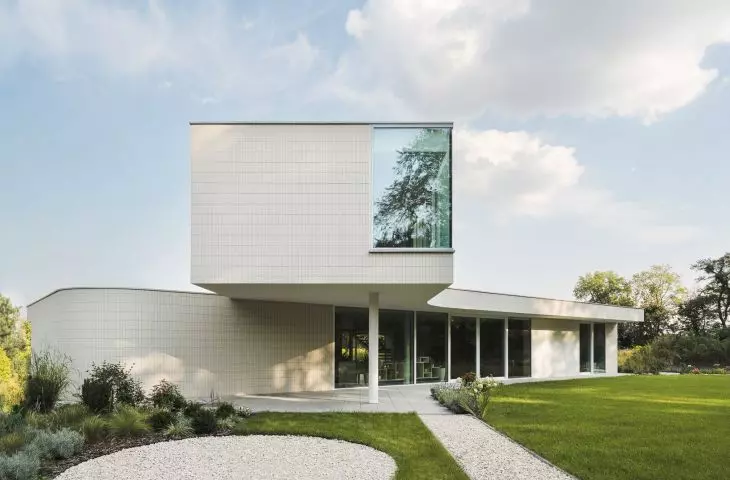The assumptions were simple—to design a house that would fit well into an unusual plot, modest and unobtrusive, yet unique. The result was a block that resembles post-war modernist residences in its aesthetics. The Paweł Lis Architekci is responsible for the concept.
"Swoosh" is a sound-mimetic word, which in English describes the sound produced by the sudden movement of air or water masses. The SWOOSH house probably does not make such a sound, although it has a bit in common with it. This is because the form of the building designed by Pawel Lis was inspired by the shape of a boomerang, which, as it rolls in circles, generates a rather characteristic sound. Where did the idea for such an arrangement come from?
SWOOSH house
Photo: Oskar Tuszynski © Pawel Lis Architects
boomerang-shaped house
SWOOSH house is a single-family house with two floors, providing residents with 220 square meters of living space. It was built in 2023 in Strzykuły, a small village located a dozen kilometers from the center of Warsaw.
SWOOSH house
Photo: Oskar Tuszyński © Paweł Lis Architekci
The first floor of the building looks typical, planned as an elongated, cuboid block with a rounded corner on the southeast side. The floor is a bigger surprise—it was set on the axis of the first floor and rotated by 60 degrees with respect to the longer side of the first floor. Here, too, one of the corners has been rounded, while a large glazing has appeared in the other. On the west side, the overhanging floor protrudes above the outline of the building's foundations, creating a spacious arcade, supported by a slender single pillar.
SWOOSH house
Photo: Oskar Tuszynski © Pawel Lis Architects
a view on all sides of the world
The atypical layout of the house had a beneficial effect on the amount of light that reaches the interiors.
The existing access to the building forced the front to be positioned on the east side. The entrance to the house is highlighted by a large corner window, through which you can see the openwork staircase leading to the first floor. The living area and bedroom on the first floor open to the west towards the tall greenery. The overhanging first floor with the study and children's rooms curves toward the south. A corner window in the study also allows a view to the west.
- explains the architect.
SWOOSH house
Photo: Oskar Tuszynski © Pawel Lis Architekci
modernist case study
The author does not hide his inspiration from modernist architecture :
Looking at it, the pavilion houses built in 1945-1966 in the Case Study Houses program come to mind.
- claims Pawel Lis.
A rather bold comparison, given that the Case Study Houses were built based on designs by some of the best post-war architects in the United States—including Richard Neutra, Eero Saarinema and Archibald Quincy Jones.
SWOOSH house
Photo: Oskar Tuszynski © Pawel Lis Architekci
However, it is hard to resist the impression that modernist aesthetics were an important point of reference during the development of the concept. The designer used several elements characteristic of this type of architecture. Thus, there appear large horizontal glazing, a body reduced to the simplest geometric forms, a pillar supporting an overhanging floor or, finally, snow-white on the facade, a motif heavily exploited in modernist realizations of the interwar period. In the case of the suburban villa, the color was muted by the use of a regular pattern, reminiscent of ceramic tiles.
SWOOSH house
Photo: Oskar Tuszyński © Paweł Lis Architekci
flat roof
The realization of some points from Corbusier's prescription for a modernist house, however, is lacking. In his works, the Swiss architect emphasized the role that the roof surface can play in modern houses. In the case of the SWOOSH house, the solution chosen by the designer leaves something to be desired. The flat roof of the house has been poured with gravel, and no garden or at least a terrace with a space for relaxation has been organized on it—instead, there will be photovoltaic panels and energy storage systems to help store the electricity produced. However, the realization has not yet come to an end, so perhaps part of the roof will also be put into use for residents.
SWOOSH house
Photo: Oskar Tuszynski © Pawel Lis Architects
not wasting a drop
The roof garden is not there for now, but the greenery around the house is rather abundant. The building is surrounded on three sides by a dense stand of trees, and a small garden has been designed directly at the back of SWOOSH house. The dynamic layout of the alleys is reminiscent of the trajectory of the boomerang flight that inspired the form of the house. The designers also took care of proper drainage of the property—rainwater is stored by a retention system and then used to water the plants. Lush vegetation and organic shapes of the garden alleys create a classic contrast with the austere body of the building. Is this enough to make the residents of SWOOSH house return home as eagerly as a boomerang to its owner?

























































